This Locomobile racing car known as Old 16, at one time was referred to as “The Greatest American Racing Car”. That title was first used by the press and later by the Locomobile Company of America in advertising after the 1906 Vanderbilt Cup Race, an event which was followed around the world.
This Locomobile won the elimination race held before hand for all of the American entries. The race was used to pick only five out of the twelve U.S. made cars that entered the race. In setting up the qualifying this way, the Vanderbilt Cup Race committee was able to have the best of the American cars competing with the foreign cars, which were thought of as superior at the time. The five selected in addition to the Locomobile were the Thomas, Haynes, Christie and the Frayer-Miller.
The color photographs shown here are courtesy of The Henry Ford Museum, were the car now resides in much the same condition as it was when it won the 1908 Running of the Vanderbilt Cup Race. This series is being presented in parts and is not intended to be a story of the races, which have been covered many times before including here. We intend it to be more of a photo essay about the car, using the photos from The Henry Ford, along contemporary press photos, captions and articles.
Part I will familiarize you with the car as it is today and how the press covered it in 1906. In Part II we will cover post race press coverage and photos from 1907. In the mean time, to learn more about the car you can look back to earlier posts on Old 16 here on The Old Motor.
The two photos (above) from The Automobile, September 13, 1906, show both sides of the huge 1,197 c.i. four-cylinder engine. It has side exhaust valves along with overhead intake valves that are operated by pushrods and rocker-arms. It is shown at the time wearing an exhaust manifold and an engine pipe. The carburetor appears to have been made by the company as it resembles some of its later efforts.
The dash and controls are shown (above). An oil tank is located in the top of the cowl, behind the dash board and the handles of the four oilers supplied by it can be seen in the very middle.
The gauge at the top is for air pressure in the gas tank, which was maintained by the riding mechanic with the hand air pump resting on the floor. This air pressure feeds gas forward to the carburetor.
The Bosch coil and switch on the dash was a later addition for ease of starting. It along with a high tension Bosch magneto replaced the original ignition which was by make and break. Locomobile would stay with this early form of ignition until the 1911 model year.
The two photos (above), also from The Automobile show the dash and controls (left) as they were during the 1906 running of the race. The (right) photos clearly shows the rocker-arm operated inlet valves.
The engine as it is today, with very few changes since the two races. The timing gears which operate the two camshafts, are at the back of the engine as was used by Mercedes and the exhaust gear is shielded under the round ribbed aluminum cover seen at the rear of the engine.
Above the horizontal structural cross piece of the cowl that is drilled for lightness, is the oil tank and below it the oil lines to the various engine bearings. The magneto is a period Bosch D4 unit which replaced the original low tension unit. The spark plugs which take the place of the original priming cups, are seen in the bronze port plugs above the exhaust valves at the top the cylinder blocks.
The first part of an article in The Automobile, dated October 4, 1906, (above, the balance below) is quite interesting and tells of the Locomobiles extensive preparations and their “Auto Camp” which housed the team before and during the race.
The left hand photo shows a young man standing behind a spare crankshaft in what appears to be a wash tub used for cleaning parts. Note that the crankshafts rod bearing journals are gun-drilled, along with the large square webs between the front and rear rod journals for lightness.
The second photo shows the two cars (one was a spare in 1906) in the race compound that was at an inn located on the race course. Note the security fence of “bird net wire”, two of the 150 thirty-two candle power bulbs can be seen hanging so that “Neither day nor night is taken into account”. On the left can also be seen a fully equipped blacksmiths shop and forge.
The remainder of the very interesting article about the Locomobile “Auto Camp” can be seen (above). The two photos show views of the fully equipped machine shop and the above mentioned mentioned wiring and electric light bulbs. The article also tells of the “working cars” of which there where five cars complete with drivers to handle the needs of the comings and goings of the team and its supplies.
A detail photo (above) shows a hood-latch which was standard Locomobile issue and the beautifully made bracket behind it, which is drilled for lightness and secures the rear hood strap.
The famous car is still wearing the paint applied for the 1908 running of the race. Artist Peter Helck who owned the car between 1941 and his death in 1989, promised the original crew members that he would leave the car as original as possible and not restore it. When he passed it then went on to his son Jerry, followed by The Henry Ford Museum.
As an example of the companies fine work, note the bolt head seen holding the hood strap bracket with the milled screw driver slot in it. The company even made the bolts that were used in all of the firms cars out of heat-treated chrome nickel steel, which was also used for most of the other parts of the cars chosen to made of steel. All of the bolts used by them were of twenty threads per inch regardless of diameter, so as to strike a good balance of the benefits of both coarse and fine threads. Locomobile at the time and through on to the 1920s had one of the most advanced engineering departments, machine shops, forging departments, and heat-treating facilities in the country.
This advertisement (above) published after the race by Locomobile tells of the remarkable showing of the car and crew, who finished in tenth place and how they set the fastest lap of the race. Due to poor conditions and the “non-skid tires” needed and the resulting tire trouble caused by them, the car was hampered by tire trouble during most of the race.
The team also did not have the more modern quick-detachable tires that all of the foreign teams used. The Locomobile crew had to change its tires the old fashioned way, which resulted in them having to spend much more time changing “shoes” as they were called, and could have very well cost them the race. In the 1908 running of the Vanderbilt Cup Race, the car was equipped with the more modern rims which helped it to win the race. See Part II here.


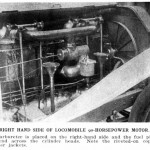
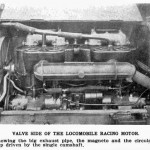
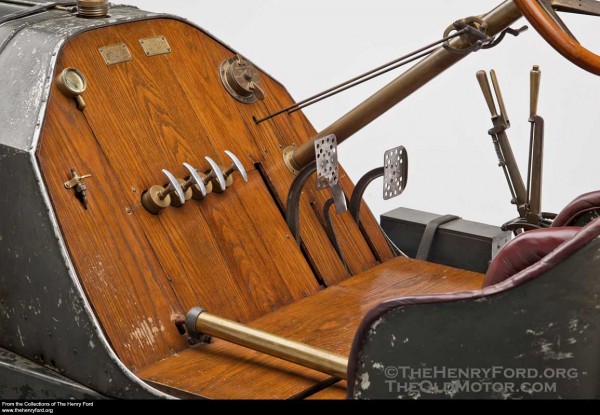
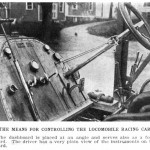
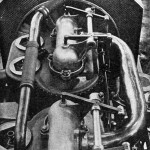
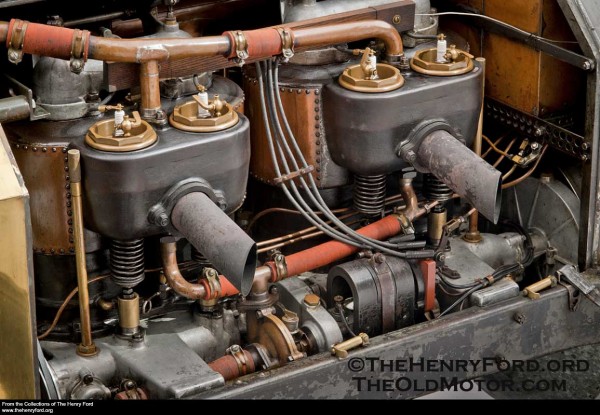
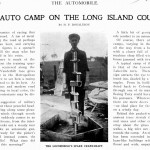
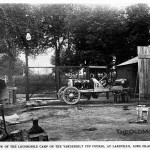
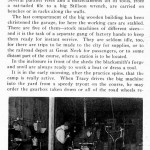
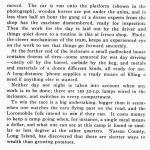
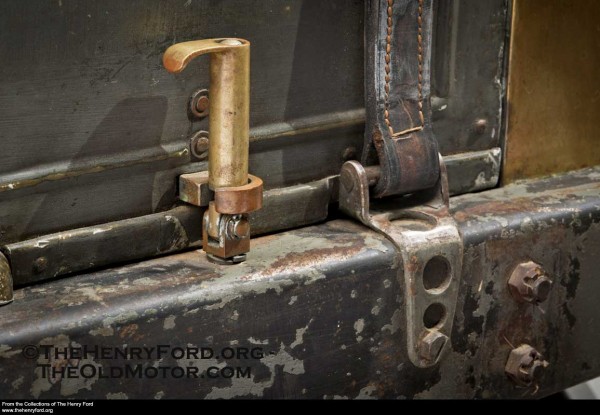
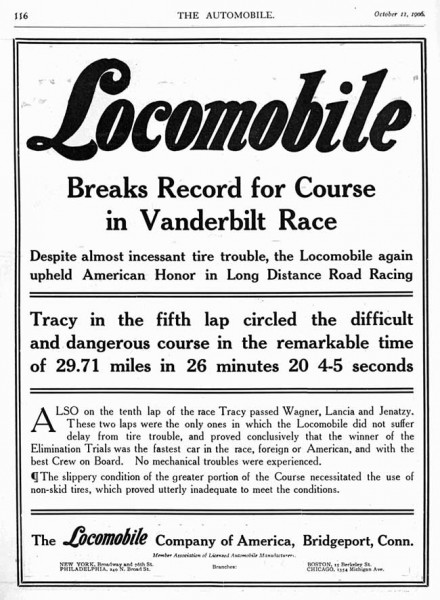
Dave, Last time I was at the Henery Ford I was told the block was cracked on OLD 16 and they will no longer run it. It this correct? Ed Minnie
Ed, Yes Old 16 is now silent as the conservators at the Henry Ford discovered small cracks starting at the top of some of the cylinders. They could very well have been there for years and are not affecting its operation, but in the interest of not causing any harm to this “Mona Lisa” of American treasures they made the decision to at least for now not run it.
While at Cornell in 1967, I wrote Peter Helck after reading about Old 16 in Old Cars Weekly. I wanted to buy the Loco! We wrote back and forth a few times, he finally said it was NOT for sale, but he did offer me his Benz, “Rabbit the First” for $25,000! I didn’t buy it. He did send me an autographed print of his painting of the Loco on the Vanderbilt course, and suggested I start with something less ambitious. I bought a 1963 Healey. . .
Still have the letters, and of course the print. Met him late in his life at a Mercer gathering, he did not remember the exchange, but had a good chuckle about it. He said it must have happened, ’cause you (me) kept the evidence!
I have a picture in a wooden frame of the 16 car. Really nice wish could add photos to show would like some history on picture
Rode in Old 16 several times when I was a kid in the early 1960’s. Peter Helck’s son, Jerry Helck, lived in town and worked with/was a friend of my Dad’s. It sounded as awesome as it looks.
What was the original color of the body? I have seen it as a light color in a B & W photo and this gray color in the Ford Museum.
This is the original paint.
I knew Peter Helck and sat in Old 16 in his barn at Boston Corners in 1986. It was in between his Mercer Race About and the 1923 Mercedes he bought for his wife on her birthday that year! He was a good host and a very nice man!!
My Dad got a photo of No. 16 taking the checkered flag at a meet in Carmel, NY in the late 40s. That pic later hung in the Bella Vista inn in Centerport for many years.